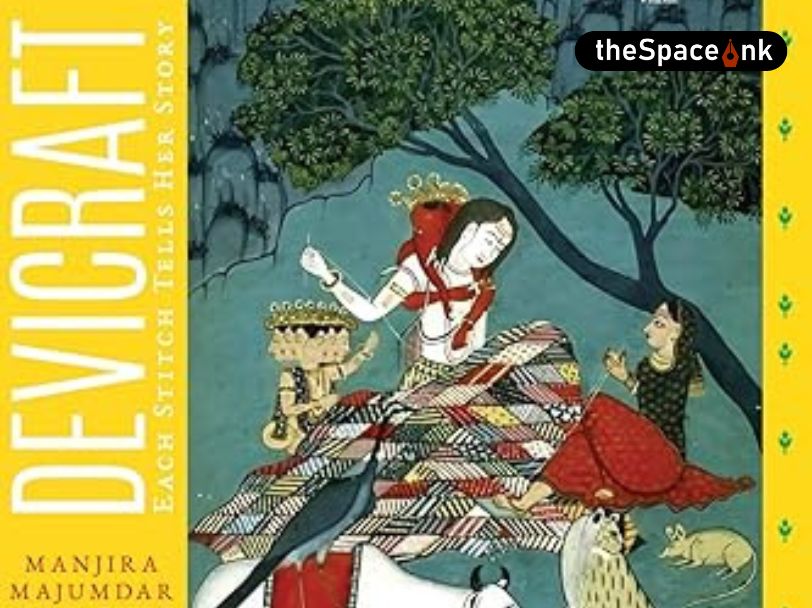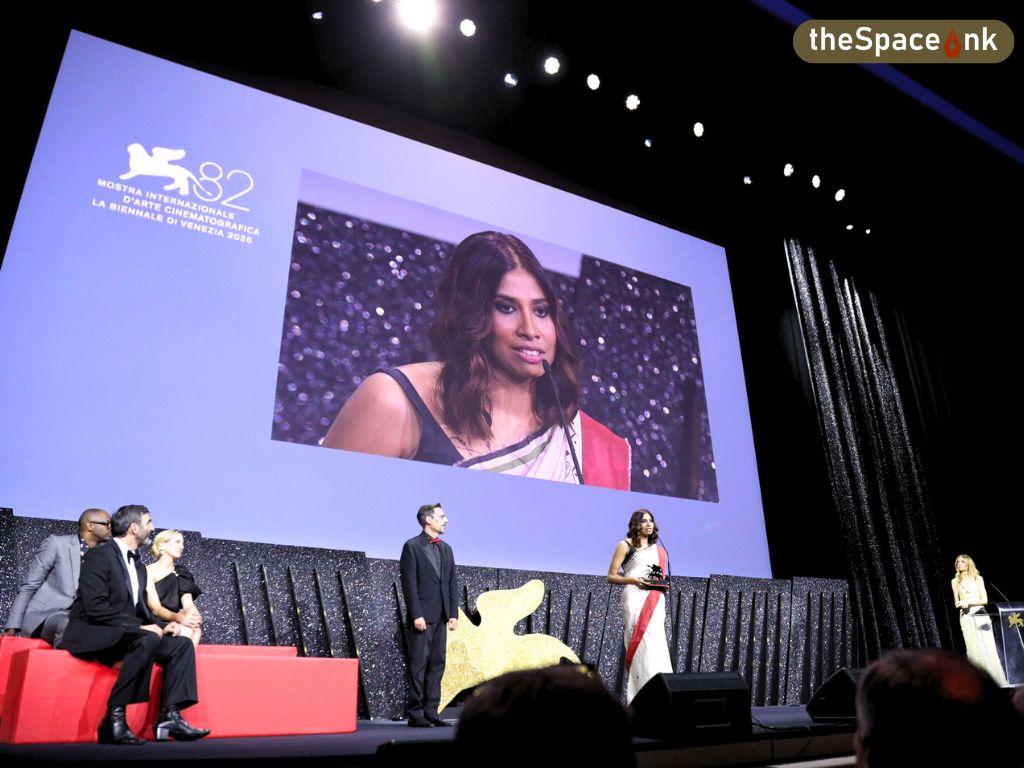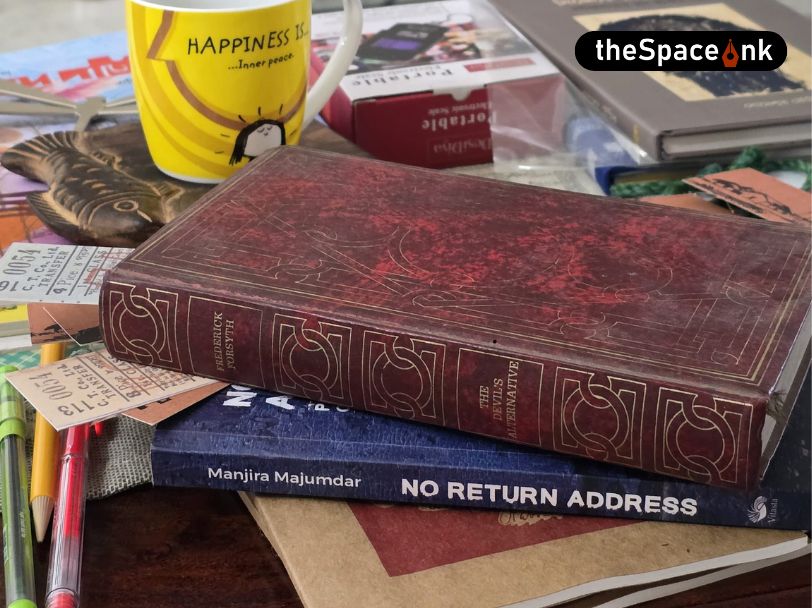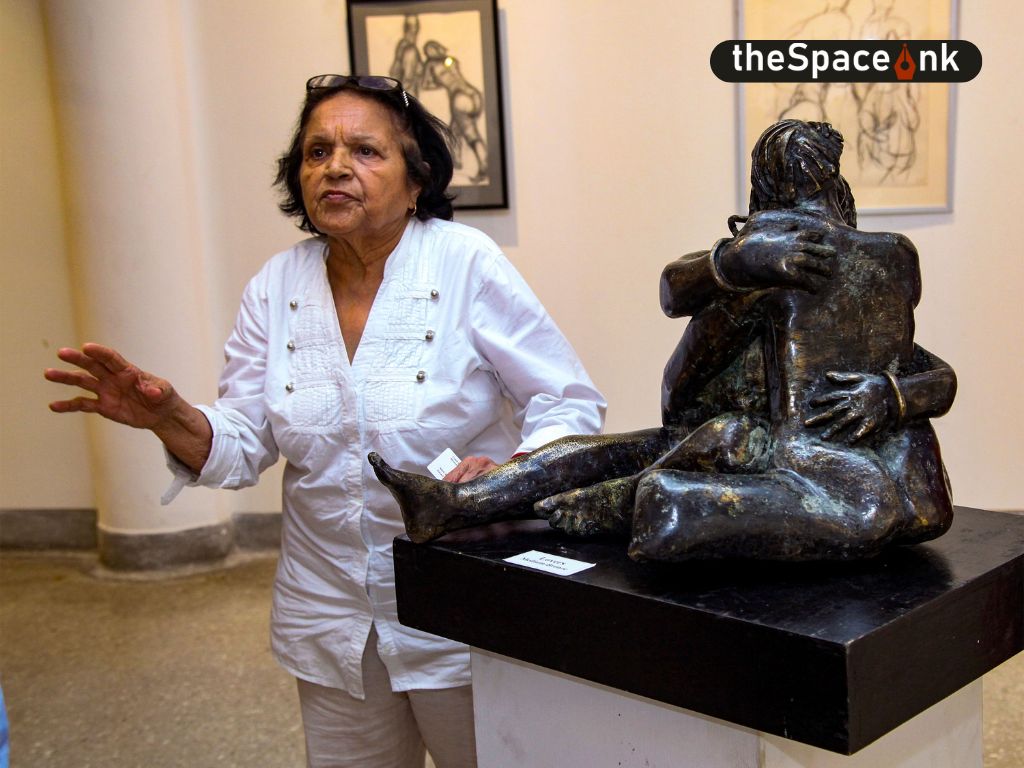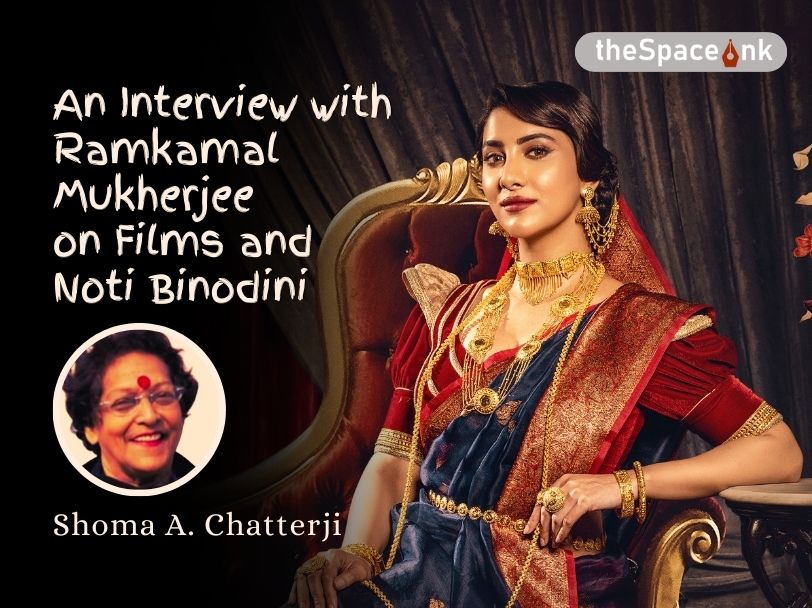The cover of Manjira Majumdar’s Devicraft Each Stitch Tells Her Story sets the tone for the book. It is an 18th century Pahari miniature where Lord Shiva is shown helping Parvati stitch a quilt.
In the unorganized traditional and folk arts sector, men and women have always worked alongside each other, but women have always remained away from the limelight. Recent years have witnessed focused efforts to highlight the contributions of women in these sectors. As Mala Pal, a woman idol maker of Kumartuli (pg 66) says, “Before us women sculptors, there were others…I have heard about Kamakhya Pal who sculpted idols in the fifties.” And of course, her mother and aunts were also involved. She attributes the recent focus on women artisans to media coverage.(Devicraft)
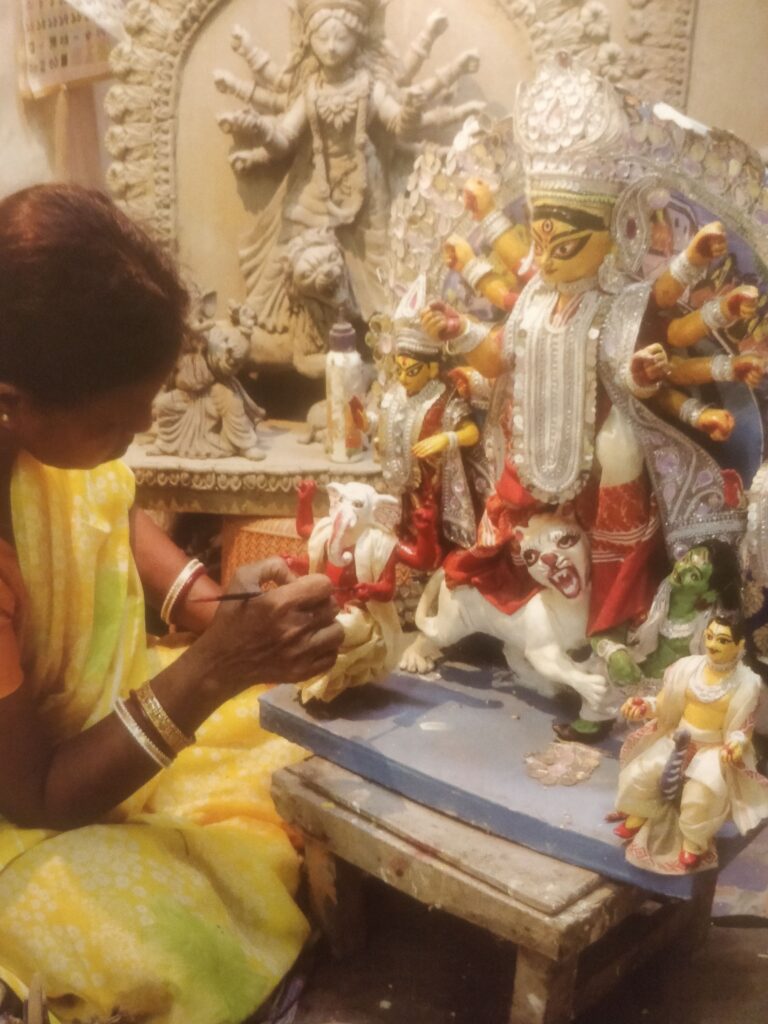
Not only conventional media but individuals and various organizations have played a major role in bringing women artisans to the forefront through events, fairs and exhibitions. While talking about contributions of individuals, one cannot but mention Kamaladevi Chattopadhyay. She worked relentlessly for the promotion of Indian handicrafts and handlooms, to uplift the socio-economic standard of Indian women crafts persons. She played a pioneering role in bringing women artisans to the forefront. In the later years, Laila Tyabji, Jaya Jaitly and Ruby Palchoudhuri, and others, have done much to highlight the women crafts persons. In Bengal particularly, Crafts Council of West Bengal, Sasha and the West Bengal Government have focussed on women artisans. But that calls for a separate discussion.(Devicraft)
She has, without being melodramatic, compressed into a hundred-and nine-page book, the importance, and the role of women artisans in the worship of Devi in her various forms
Manjira has made a remarkable effort in putting together Devicraft Each Stitch Tells Her Story. She has, without being melodramatic, compressed into a hundred-and nine-page book, the importance, and the role of women artisans in the worship of Devi in her various forms. She has concentrated on four crafts interacting with the artisans in their milieu and has ably brought out the environment in which they work. She has combined her journalistic experience and love for the artisanal crafts to write a book that focusses on the skill of women crafts persons.
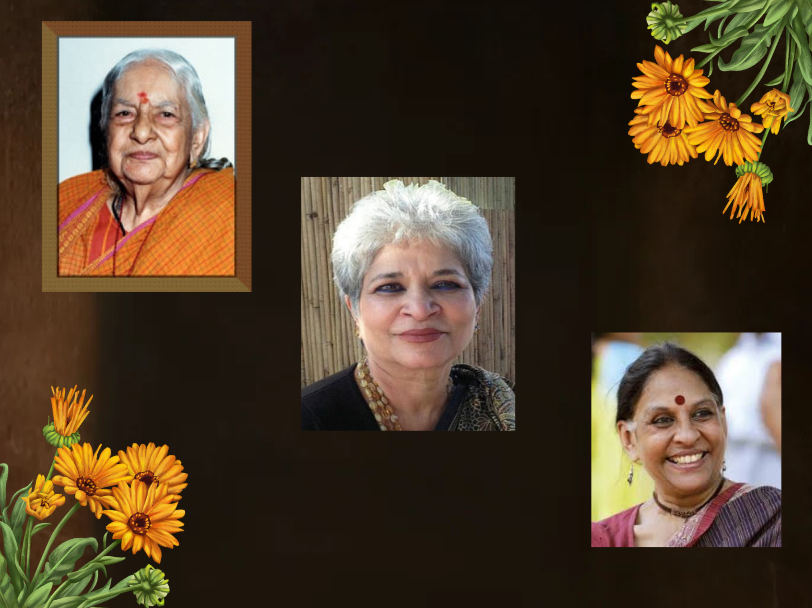
In Devi puja/aradhana the alpona too is another art form where women are extensively involved. The text is interspersed with brilliant photographs by Ishanee Sarkar. While going through the book, I felt the photographs needed breathing space to create a greater impact. Following is an excerpt from the interview with the author.(Devicraft)
Also Read: Book Review: No Return Address-Stories of Displacement and Alienation
1. Why and when did you think of writing Devicraft-Each Stitch Tells Her Story?
I have always been interested in artisanal crafts but not those sold from boutiques, but at various fairs or melas. Plenty of these are now held all over India, and Bengal is no exception. I observed that saris woven by weavers, especially women, in a state like Tamil Nadu, have a tag of the master weaver’s name along with the price tag etc., more so, in the state handloom showrooms. This is indeed a nice way to acknowledge women’s creativity and their labour, for which they may not be earning the same wages as men, as is often the case.
2. What is the significance of the word ‘Stitch’ in the title of the book?
I am basically talking about four crafts in this book as this is not a book on only textiles but shola, idol making, kantha embroidery and taant weaving. There are several others such as patachitra, mat weaving, doll making, terracotta and others, and I have connected these products to the year-long worship of dev and devis (mostly devis) in our State, culminating in the annual Durga Puja celebrations, which is but a carnival. If people are preferring nylon carpets and Corella dinner sets over chatai and pottery, where do these products go? They are being used for pandal installations as are idols crafted with clay and dressed in fabrics. Whether you are stitching a piece of cloth or a garland of flowers made with shola – it is all about spinning that yarn or thread first. My book cover depicts Shiva and Parvati doing the same in making a patchwork quilt as depicted in a Pahari miniature of the 18th century. (Devicraft)

3. When you conceived the book what kind of readership base did you have in mind?
Through my writing on the arts and crafts as a feature writer, I devised a book that would be pictorial. A coffee table book is not text heavy, here I have deliberately written it in a manner as though I am having a conversation with readers. I feel, wherever the readers are located, they can get a glimpse about what our worship is all about, and the crafts associated with it. I hope the young Bengalis (especially in the diaspora) read it to get an idea of livelihoods and the artisanal arts. Having hedonistic fun over a celebration is alright but knowing about one’s culture and heritage is essential. The first thing I like to check out, whenever I am visiting a country, is its crafts. Mexico still has beautiful handicrafts which the USA unfortunately, doesn’t.(Devicraft)
Also Read: Ishwarchandra Vidyasagar and Homeopathy
4. How did you go about gathering facts?
I always talk to artisans whenever I visit fairs. I am keen to learn about their lives, especially if they happen to be women. This was backed by research on the materials that are used. In fact, I only used bits of research I did as I was very clear that Devicraft Each Stitch Tells Her Story was not going to be a scholarly piece of work. It is based on observations and interactions. I personally find that academic writing can often be heavy and, with the habit of reading on the decline, we have to package our writing attractively. (Devicraft)
5.What kind of hurdles did you face while trying to establish contacts with the artisans?
The hurdles were several because most artisans do not want to talk, or only want to talk, about their miseries, which I sympathise with, but unfortunately, cannot solve. The men do not want their women to talk and many of them are very shy. I had to buy some of their products because I did not wish to buy information. But once in their homes, they opened up because I chatted with them over tea and meals. I have tried to present facts as given by them. (Devicraft)
. 6. Your book is very much a cultural history/tale highlighting the role of women in the folk and traditional crafts of West Bengal. Do you feel that our younger generation would appreciate your efforts and find it useful as a study material?
I have somewhat answered this in question 3. I would be happiest if it was used in the form of study material. I am very grateful to Mr Jawhar Sircar who has written extensively on religious worship to add a certain perspective on the evolution of Durga worship in Bengal; designer Ms Swagata Ghosh, of Sasha Crafts, who works with craftswomen at the grassroots level, has talked about certain craft traditions that Bengal lost due to the partition. (Devicraft)
7. What more do you feel needed to be added to Devicraft … by way of contents?
Once you submit your book, it is no longer yours. The publishers take over in matters of design, etc. I do find that I have confused some vahan or the animal which each god or goddess rides. For instance, Ma Sitala rides a donkey and not a horse but the horse represents mahamari or epidemics. Maybe all the animals were taken therefore Sitala was left with the donkey! The photographs by Ishanee Sarkar do not run parallel with the text but as someone mapping the city’s celebrations as seen through a young woman’s eyes. (Devicraft)
- Book Name: Devicraft Each Stitch Tells Her Story
- Author: Manjira Majumdar
- Price: 2500
- Binding: Hardbound
- ISBN: 9788119670482
- Pages: 120
- Publisher: Vitasta Publishing Private Limited
- Year of Publishing: 2025
All Rights Reserved
Image courtesy: Author
Arundhati Gupta is a Kolkata based food enthusiast, communications consultant, freelance writer and a translator.


